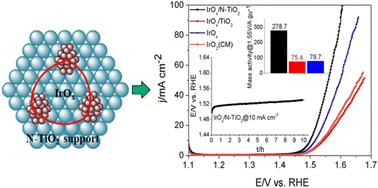Reducing the Ir consumption without compromising the catalytic performance for the oxygen evolution reaction (OER) is highly paramount to promote the extensive development of the environmentally-friendly solid polymer electrolyte water electrolysis (SPEWE) system. Herein, TiO2 is doped with N through facile NH3 gas treatment and innovatively employed to support IrOx nanoparticles towards acidic OER. N-doping action not only dramatically boosts the electrical conductivity and dispersing/anchoring effects of TiO2, but also effectively improves the electron-transfer procedure. As a result, the IrOx/N–TiO2 electrocatalyst exhibits prominent catalyst utilization, catalytic activity and stability. Specifically, the overpotential required to deliver 10 mA cm−2 is only 270 mV, and the mass activity climbs to 278.7 A gIr−1 @ 1.55 VRHE. Moreover, the single cell voltage is only 1.761 V @ 2.0 A cm−2 when adopting IrOx/N–TiO2 as the anode catalyst, which is 44 mV lower than that of the commercial IrO2 counterpart.

